Programmable Diffuser
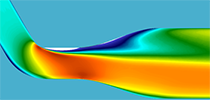
An experimental/numerical investigation demonstrates the utility of a new approach to diffuser design using a programmable diffuser testbed integrated with active flow control (AFC) to suppress total pressure distortions and enhance recovery in aggressive settings. This work defines the design space and geometries of aggressive offset diffusers, beyond the currently established design guidelines, which are enabled by AFC and support assessment of their performance benefits at the conceptual design stage. In particular, this research focuses on the inlet aspect ratio and the bend angle and curvature.
REFERENCES
Li, S., Fletcher, J., Vukasinovic, B., Mace, J., Glezer,A., Mani, M., Stratton, Z., and Spyropoulos, J.T., Control of Flow Circulations in a Programmable Offset Diffuser, AIAA Paper 2025-3392.
Stratton, Z., Spyropoulos, J.T., Mani, M., Mace, J., Li, S., Fletcher, J., Vukasinovic, B., and Glezer, A., Development of an Aggressive Offset Diffuser Testbed with Adaptive Design Characteristics, AIAA Paper 2025-2108.
Circulation Control over a Cylinder

Aerodynamic loads engendered by circulation control on a rotorcraft cylinder boom are used to effect counter torque to replace the conventional tail rotor in NOTAR configurations. The present experimental investigations explore the utility of segmented Coanda actuation on a circular cylinder model for generating streamwise and cross-stream loads that are insensitive to the direction of the cross flow using spanwise arrays of fluidically oscillating wall jets with specific emphasis on the interaction of the control jets with the cross flow and their effects on the near wake.
REFERENCE
Rackers, N., DeSalvo, M., Vukasinovic, B., and Glezer, A., Circulation Control Over a Circular Cylinder by a Spanwise Array of 3D Coanda Wall Jets, AIAA Paper 2025-1681.
Jet-induced Vortices in Turbulent Boundary Layers
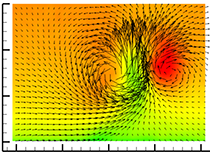
The interaction of surface jets with a flat plate turbulent boundary layer in a uniform stream is investigated, having the jet characteristic scale much smaller than the local characteristic boundary layer thickness. Of specific interest is the effect of the jets' inclination (pitch) and yaw angles relative to the uniform flow above the boundary layer on the evolution of counter-rotating axial vortex pairs that are induced by the shear between the cross flow and the issuing jet, and their effect on spanwise distributions of cross-stream momentum flux relative to the baseline boundary layer. The imbalance in circulation between the vortex pairs is assessed, along with the induction of secondary vortices off the surface vorticity layer.
REFERENCES
Barnabas, T., Vukasinovic, B., Glezer, A., DeFore, M.C., and Harris, C., Wall-Bound Streamwise Vortices formed by Embedded Jets in a Turbulent Boundary Layer, AIAA Paper 2025-3394.
Barnabas, T., Vukasinovic, B., Glezer, A., DeFore, M.C., and Harris, C., Interactions of Controlled Streamwise Vortices With a Turbulent Boundary Layer, AIAA Paper 2025-1489.
Barnabas, T., Nichols, D.A., Vukasinovic, B., Glezer, A., DeFore, M.C., and Harris, C., The Evolution of Streamwise Vortices Formed by Inclined and Swept Round Jet within a Turbulent Boundary Layer, AIAA Paper 2024-3634.
Circulation Control for Short Takeoff and Landing (STOL)

Controlled modification of an airfoil's circulation to effect significant lift increments by using a discrete fluidic-based actuation near its trailing edge is utilized by exploiting the Coanda effect over either a bluff trailing edge or the airfoil's flap in a nominally 2-D airfoil and on a channel wing. In either application, trailing edge circulation control (CC) for enhancement of short takeoff and landing (STOL) was effected using independent arrays of fluidically oscillating jet actuators over integrated Coanda surfaces along the trailing edges of the wing's outer span segment and along the channel.
REFERENCES
Vukasinovic, B., Funk, R.B., Johnson, C., and Glezer, A., Circulation Control of a Channel Wing Using Discrete Coanda Actuation, AIAA Paper 2024-3796.
Vukasinovic, B., DeSalvo, M., Glezer, A., and Funk, R.B., Aerodynamic Flow Control of a Channel Wing, AIAA Paper 2023-4348.
Vukasinovic, B., Glezer, A., and Funk, R.B., DARPA CRANE Circulation Control using Arrays of Discrete Fluidic Actuator Jets, AIAA Paper 2023-1992.
Forebody Vortices
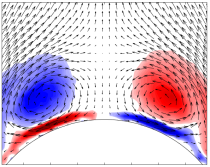
The flow over an inclined slender axisymmetric cylinder with an ogive forebody is investigated experimentally at high angles of attack, up to 65 degrees. Particular interest is placed on the evolution and control of net side forces that are associated with asymmetries of the forebody vortices. Moreover, due to the high incidence, the forebody vortices interact with the near-wake vortices of the cylinder, leading to the formation of a vertical 'stack' of counter-rotating streamwise vortices whose order depends on the dominant asymmetry of the forebody vortex pair. In addition, the unsteady coupling between the body and its near wake can lead to strong yaw-roll instabilities. This work explores manipulation of the body-vortex system and the side force by flow control aimed at bi-directional control of the body's trajectory and suppression of the yaw-roll instability.
REFERENCES
Lee, E., Vukasinovic, B., and Glezer, A., Aerodynamic Control of a Cylindrical Platform at High Angles of Attack using Forebody Bleed, AIAA Paper 2024-1516.
Lee, E., Vukasinovic, B., and Glezer, A., Controlled Loads on an Axisymmetric Platform at High Incidence using Forebody Aerodynamic Bleed, AIAA Paper 2023-0432.
Lee, E., Huang, Y., Vukasinovic, B., and Glezer, A., Aerodynamic Flow Control of an Unstable Slender Cylindrical Body at High Incidence, AIAA Paper 2021-2610.
Lee, E., Huang, Y., Vukasinovic, B., and Glezer, A., Controlled Aerodynamic Loads on a Slender Axisymmetric Body at High Incidence, AIAA Paper 2021-1943.
Inlet in Cross Flow and Ground Vortex

The inlet flow of a nacelle model is investigated experimentally in the presence of cross flow that induces a complex, azimuthal separation pattern over the inner surface of the inlet's windward side. This separation increases in its topological complexity as the intake speed of the inlet increases for a given cross flow speed. Additionally, a ground vortex can form and be ingested into the inlet off a surface in proximity to the inlet in cross flow. The size of the vortex core, its circulation, and unsteadiness depend on the intake and cross flow speeds and on the surface proximity. The evolution of the flow separation topology and ingestion of the ground vortex and their receptivity to flow control strategies are investigated in a state-of-the-art cross-flow wind tunnel.
REFERENCES
Nichols, D. A., Vukasinovic, B., and Glezer, A., On the formation of a ground vortex in crossflow, J.Fluid Mech. 1012, A14, 2025.
Nichols, D. A., Vukasinovic, B., and Glezer, A., Control of a Nacelle Inlet Ground Vortex in Crossflow, AIAA J. 63, pp. 2199-2210, 2025.
Nichols, D. A., Vukasinovic, B., and Glezer, A., Control of a Nacelle Inlet Ground Vortex, AIAA Paper 2024-2138.
Nichols, D. A., Vukasinovic, B., Glezer, A., and Rafferty, B. Aerodynamic Control of an Inlet Flow in Crosswind Using Peripheral Bleed Actuation,, J. Propul. Power 40, pp. 111-122, 2024.
Nichols, D. A., Vukasinovic, B., and Glezer, A., The Formation, Evolution, and Sustainment of Inlet Ground Vortices, AIAA Paper 2023-3891.
Nichols, D. A., Vukasinovic, B., and Glezer, A., Scaling Characteristics of Ground Vortices in a Nacelle Inlet Flow Field, AIAA Paper 2023-1981.
Nichols, D. A., Vukasinovic, B., Glezer, A., and Rafferty, B. Formation of a Nacelle Inlet Ground Vortex in Crosswind, AIAA Paper 2022-1698.
Nichols, D. A., Vukasinovic, B., Glezer, A., DeFore, M. C., and Rafferty, B. Steady and Unsteady Control of Nacelle Inlet Flow in Crosswind, AIAA Paper 2021-1556.
Nichols, D. A., Vukasinovic, B., Glezer, A., DeFore, M. C., and Rafferty, B. Fluidic Control of Nacelle Inlet Flow in Crosswind, AIAA Paper 2020-2955.
Nichols, D. A., Vukasinovic, B., Glezer, A., DeFore, M. C., Rafferty, B., and Palacios, F. D. Characterization and Control of Nacelle Inlet Flow in Crosswind, AIAA Paper 2019-3685.
Flow Control Mechanisms

Fluidic control of a 3-D separation cell that forms in the cross flow over a nominally 2-D convex geometry is investigated experimentally. Actuation is effected by exploiting the unsteady interactions between spanwise arrays of fluidic oscillating jets of varying deployment periodicity and streamwise vorticity concentrations within the separation cell. The effect of these interactions on the topology of the separated flow and its ensuing reattachment are investigated with specific emphasis on the spatially-evolving interaction domains of the individual jets which create unique localized cells that are bounded by streamwise vortices and terminate in the fully attached flow.
REFERENCES
Peterson, C.J., Vukasinovic, B., Smith, M.J., and Glezer, A. Control of Flow Separation Over a Curved Surface using Fluidic Actuator Arrays with Variable Spanwise Periodicity, AIAA Paper 2021-2004.
Peterson, C.J., Vukasinovic, B., Smith, M.J., and Glezer, A. Controlled Attachment of a Separated Boundary Layer in an Adverse Pressure Gradient Over a Curved Surface, AIAA Paper 2020-2950.
Peterson, C.J., Vukasinovic, B., and Glezer, A. Control of a Closed Separation Domain in Adverse Pressure Gradient Over a Curved Surface, AIAA Paper 2019-1900.
Flow/Thrust Reverser
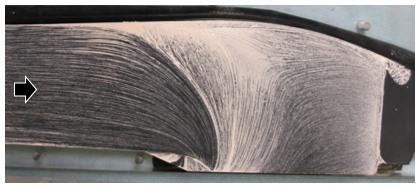
A shorter flow/thrust reversing section necessitates a decrease in the radius of curvature over which the flow turns, which results in flow separation over the turning surface, thereby generating losses. This, in turn, reduces the magnitude of the reverse thrust due to reduction in the mass flow rate. For these reasons, the present experimental investigation explores utilization of active flow control for mitigation of the flow separation over a shortened turning section. Hence, primary focus of the current work is demonstration of the feasibility of mitigation of the adverse effects associated with length reductions in flow/thrust reverser assemblies by the active flow control tools.
REFERENCES
Gissen, A.N., Vukasinovic, B., Packard, N.O., Brzozowski, D.P., and Glezer. A., Flow Control of a Cascade Thrust Reverser, J. Propul. Power 33, pp. 1020-1030, 2017.
Gissen, A.N., Vukasinovic, B., Packard, N.O., Brzozowski, D.P., and Glezer. A., Flow Control in a Cascade Thrust Reverser, AIAA Paper 2017-1453.
Flow Diverter

Regulation of flow diversion from a primary rectangular channel into a branched secondary duct is investigated experimentally using active flow control. The flow distribution between ducts is effected by controlling the inherent separation at the upstream edge of the compact secondary duct inlet using an integrated spanwise array of the flow control elements. The role of the flow control in the regulation of the diverted flow is assessed in terms of the fraction of the oncoming flow diversion into the secondary duct, along with the reduction in internal flow losses.Objective is to enable a 'tunable' fraction of the diverted flow between the lowest (natural) and the highest (maximum flow control assisted) limits.
REFERENCES
Peterson, C.J., Vukasinovic, B., and Glezer, A. The evolution and scaling of controlled flow separation at the inlet of a diverging channel, Exp. Fluids 66, 148, 2025.
Peterson, C.J., Vukasinovic, B., and Glezer, A. Laser pulse separation measurements for spectral flow analysis using particle image velocimetry, FME Transactions 48, pp. 1-6, 2020.
Peterson, C.J., Vukasinovic, B., and Glezer, A. Characterization of Controlled Flow Separation, AIAA Paper 2018-1282.
Peterson, C.J., Vukasinovic, B., Glezer, A., Saripalli, K.R., and Packard, N.O., Active Flow Control of Separation in a Branched Duct, AIAA Paper 2016-3771.
Serpentine Diffuser
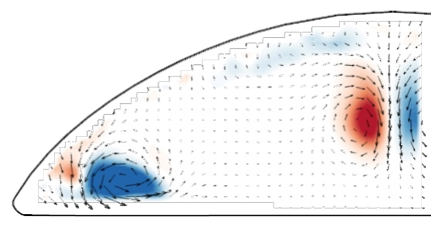
The flow in offset and serpentine diffusers is dominated by streamwise vortices that introduce flow losses along their cores and advect low-momentum fluid from the diffuser's surfaces into the bulk flow, often accompanied by the local flow separation. These coupled effects contribute to overall losses and give rise to flow distortion along the diffuser. Active flow control based on fluidic actuation is used to control the flow separation and formation and evolution of the vortices and thereby mitigate their adverse effects in offset and serpentine diffusers isolated from and coupled to the cowl inlet.
REFERENCES
Burrows, T.J., Vukasinovic, B., and Glezer, A., Lakebrink, M.T., and Mani, M. Controlled Flow in a Serpentine Diffuser with a Cowl Inlet, J. Aircraft 62, pp. 438-447, 2025.
Burrows, T.J., Vukasinovic, B., and Glezer, A., Flow Dynamics of a Serpentine Diffuser With a Cowl Inlet, AIAA Paper 2024-3540.
Burrows, T.J., Vukasinovic, B., and Glezer, A. Active Control of a 3-D Flow Separation Induced by a Transonic Shock, Exp. Fluids 62, 187, 2021.
Burrows, T.J., Vukasinovic, B., Glezer, A., Lakebrink, M.T., and Mani, M. Experimental and Numerical Investigation of Active Flow Control of a Serpentine Diffuser, AIAA J. 59, pp. 607-620, 2021.
Burrows, T.J., Vukasinovic, B., Glezer, A., Lakebrink, M.T., and Mani, M. Controlled Flow Dynamics in a Serpentine Diffuser with a Cowl Inlet, AIAA Paper 2020-2951.
Burrows, T.J., Vukasinovic, B. and Glezer, A. Control of a Transonic Shock in a Serpentine Diffuser using Surface Fluidic Actuation, AIAA Paper 2019-3687.
Burrows, T.J., Vukasinovic, B., Lakebrink, M.T., Mani, M., and Glezer A. Control of Flow Distortion in Offset Diffusers using Trapped Vorticity, Int. J. Heat Fluid Fl. 75, pp. 122-134, 2019.
Burrows, T.J., Vukasinovic, B. and Glezer, A. Flow Dynamics Effected by Active Flow Control in an Offset Diffuser, AIAA Paper 2018-4024.
Burrows, T.J., Vukasinovic, B. and Glezer, A. Fluidic Control of an Aggressive Offset Diffuser for a Supersonic Inlet, AIAA Paper 2017-4304.
Vukasinovic, B., Burrows, T.J., Glezer, A., Lakebrink, M.T., and Mani, M. Experimental and Numerical Investigation of Controlled Flow Distortion in a Subsonic Offset Diffuser by Trapped Vorticity, AIAA Paper 2017-1454.
Burrows, T. J., Gong, Z., Vukasinovic, B., and Glezer, A. Investigation of Trapped Vorticity Concentrations Effected by Hybrid Actuation in an Offset Diffuser, AIAA Paper 2016-0055.
Transonic Shock

This research focuses on active control of the separating flow over a two-dimensional curved surface when the flow becomes transonic, marked by the interplay and coupling between the shock, the incipient flow separation, and the dynamic of the ensuing separated shear layer. An important objective of the present research is to investigate and understand the indirect control mechanisms of the shock structure and stability by exploiting the coupling between the induced flow separation and the shock. Active flow control is used to modify the separated flow by inducing partial attachment and the pressure perturbations that accompany these changes couple to the shock through the subsonic flow and affect its static and dynamic characteristics.
REFERENCES
Gissen, A. N., Vukasinovic, B., Glezer, A., Gogineni, S., Paul, M. C., and Wittich, D. J. Active Transonic Shock Control, AIAA Paper 2014-0942.
Gissen, A. N., Vukasinovic, B., Glezer, A., and Gogineni, S., Active Shock Control in a Transonic Flow, AIAA Paper 2013-3116.
Vukasinovic, B., Gissen, A. N., Glezer, A., and Gogineni, S., Fluidic Control of Transonic Shock-Induced Separation, AIAA Paper 2013-0529.
Dynamic Platform

Quasi-steady and transitory controlled interactions of integrated synthetic jet actuators with the cross flow over an axisymmetric bluff body are utilized to induce localized flow attachment over the body's aft end and thereby alter the global aerodynamic forces and moments. The model orientation is varied dynamically by the support traversing mechanism. The objective of active flow control is focused on either suppression or enhancement of asymmetric aerodynamic forces and moments that result from the model's motion, demonstrating capability for flight stabilization and attitude control.
REFERENCES
Lambert, T. J., Vukasinovic, B., and Glezer, A., Fluidic control of a precessing axisymmetric body by near-wake coupling, Phys. Rev. Fluids 9, 053904, 2024.
Lambert, T. J., Vukasinovic, B., and Glezer, A. Controlled axisymmetric body-wake coupling in a pitching motion, Exp. Fluids 61, 109, 2020.
Lambert, T. J., Vukasinovic, B., and Glezer, A. A freely yawing axisymmetric bluff body controlled by near-wake flow coupling, J. Fluid Mech. 863, pp. 1123-1156, 2019.
Lambert, T. J., Vukasinovic, B., and Glezer, A. Aerodynamic Flow Control of Axisymmetric Bluff Body by Coupled Wake Interactions, AIAA J. 56, pp. 2992-3007, 2018.
Lambert, T.J., Vukasinovic, B., and Glezer, A., A Six Degrees of Freedom Dynamic Wire-Driven Traverse, Aerospace 3:11, 2016.
Lambert, T.J., Vukasinovic, B., and Glezer, A., Aerodynamic Flow Control of Wake Dynamics Coupled to a Moving Bluff Body, AIAA Paper 2016-4081.
Lambert, T.J., Vukasinovic, B., and Glezer, A., Coupled Aerodynamic Control of the Turbulent Wake of a Moving Bluff Body, Proc. ETMM11, ERCOFTAC Symposium, 2016.
Lambert, T.J., Vukasinovic, B., and Glezer, A., Aerodynamic Control of Coupled Body-Wake Interactions, AIAA Paper 2016-0053.
Lambert, T.J., Vukasinovic, B., and Glezer, A., Active decoupling of the axisymmetric body wake response to a pitching motion, J. Fluids Struct. 59, pp. 129-145, 2015.
Lambert, T.J., Vukasinovic, B., and Glezer, A., Aerodynamic Flow Control of an Axisymmetric Body in Prescribed Maneuvers, 55th IACAS Conference Proceedings, 2015.
Lambert, T.J., Vukasinovic, B., and Glezer, A., Unsteady Aerodynamic Loads Effected by Flow Control on a Moving Axisymmetric Bluff Body, AIAA Paper 2015-0827.
Lambert, T.J., Vukasinovic, B., and Glezer, A., Aerodynamic Flow Control of a Moving Axisymmetric Bluff Body, AIAA Paper 2014-0932.
Lambert, T.J., Vukasinovic, B., and Glezer, A., Yaw Control of a Moving Axisymmetric Body using Synthetic Jets, AIAA Paper 2013-0106.
Lambert, T.J., Vukasinovic, B., and Glezer, A., Unsteady Aerodynamic Flow Control of a Wire-Suspended, Moving Axisymmetric Body, AIAA Paper 2012-0073.
Streamwise Vortices
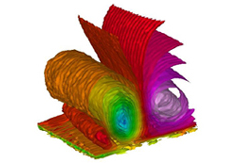
Manipulation of streamwise vorticity in a turbulent boundary layer is investigated experimentally at high subsonic speeds. Counter-rotating vortex pairs and single-sense vortices are formed and characterized using conventional passive sub-boundary layer micro-ramps and micro-vanes, respectively. Fluidic analogues of these passive devices are established by using surface-mounted synthetic jet actuators. Hybrid manipulation of streamwise vorticity within the boundary layer is demonstrated by simultaneous combination of passive and active actuation which enables robust, controllable ”fail-safe” operation that requires no net mass injection.
REFERENCES
Gissen, A. N., Vukasinovic, B., and Glezer, A., Dynamics of Flow Control in an Emulated Boundary Layer-ingesting Offset Diffuser, Exp. Fluids 55:1794, 2014.
Gissen, A. N., Vukasinovic, B., McMillan, M. L., and Glezer, A., Distortion Management in a Boundary Layer Ingestion Inlet Diffuser Using Hybrid Flow Control, J. Propul. Power 30, pp. 834-844, 2014.
Gissen, A. N., Vukasinovic, B., McMillan, M. L., and Glezer, A., Dynamics of Hybrid Flow Control in a Boundary-Layer-Ingesting Offset Diffuser, AIAA Paper 2011-3096.
Gissen, A. N., Vukasinovic, B., McMillan, M. L., and Glezer, A., Distortion Management in a BLI Inlet Diffuser using Synthetic-Jet Hybrid Flow Control, AIAA Paper 2011-35.
Gissen, A. N., Vukasinovic, B., and Glezer, A., Manipulation of Streamwise Vorticity in an Emulated Diffuser Boundary Layer Using Hybrid Flow Control, AIAA Paper 2010-4586.
Gissen, A. N., Vukasinovic, B., and Glezer, A., Controlled Streamwise Vorticity in Diffuser Boundary Layer using Hybrid Synthetic Jet Actuation, AIAA Paper 2009-4021.
Bluff Body - Turret

Flow separation off an airborne bluff-body turret (hemispherical cap elevated on a matching cylinder) can adversely affect optical transmission, and induce excess dynamic loads and structural vibrations. The transmission of optical energy through separated flows is severely degraded by the formation and advection of a hierarchy of vortical structures of decreasing scales that effect strong spatial and temporal nonuniform distribution of index of refraction. The present work demonstrates the effectiveness of active flow control in mitigation of undesirable effects via flow-separation delay and direct broadband suppression of turbulent motions, particularly those of the energy-bearing, large-scale structures. The flow control approaches include both active and hybrid (passive and active) control configurations. An alternate approach that leads to ”regularization” of the shedding structures is also explored.
REFERENCES
Vukasinovic, B., Glezer, A., Gordeyev, S., Jumper, E., and Bower, W. W., Flow Control for Aero-Optics Application, Exp. Fluids 50:1492, 2013.
Vukasinovic, B., Glezer, A., Gordeyev, S., Jumper, E., and Bower, W. W., Flow Control for Turret Aero-Optics Applications, AIAA Paper 2013-1014.
Vukasinovic, B., Glezer, A., Gordeyev, S., Jumper, E., and Kibens, V., Hybrid Control of a Turret Wake, AIAA J. 49, pp.1240-1255, 2011.
Vukasinovic, B., Glezer, A., Gordeyev, S., Jumper, E., and Kibens, V., Fluidic Control of a Turret Wake: Aerodynamic and Aero-Optical Effects, AIAA J. 48, pp.1686-1699, 2010.
Vukasinovic, B., Glezer, A., Gordeyev, S., Jumper, E., and Kibens, V., Hybrid Control of a Turret Wake, Part I: Aerodynamic Effects, AIAA Paper 2010-86.
Gordeyev, S., Jumper, E., Vukasinovic, B., Glezer, A., and Kibens, V., Hybrid Control of a Turret Wake, Part II: Aero-Optical Effects, AIAA Paper 2010-438.
Vukasinovic, B., Glezer, A., Gordeyev, S., Jumper, E., and Kibens, V., Fluidic Control of a Turret Wake, Part I: Aerodynamic Effects, AIAA Paper 2009-816.
Gordeyev, S., Jumper, E., Vukasinovic, B., Glezer, A., and Kibens, V., Fluidic Control of a Turret Wake, Part II: Aero-Optical Effects, AIAA Paper 2009-817.
Bower, W. W., Kibens, V., Nahrstedt, D. A., Vukasinovic, B., Glezer, A., Gordeyev, S., Jumper, E., and Saunders, D., Directed Energy Beam Improvement Using Binary Control for the Advanced Tactical Laser (DEBI-BATL), Proc. Beam Control Conference 2009 , April 6-10, 2009, Monterey, CA.
Vukasinovic, B. and Glezer, A., Control of a Separating Flow over a Turret, AIAA Paper 2007-4506.
Axisymmetric Body
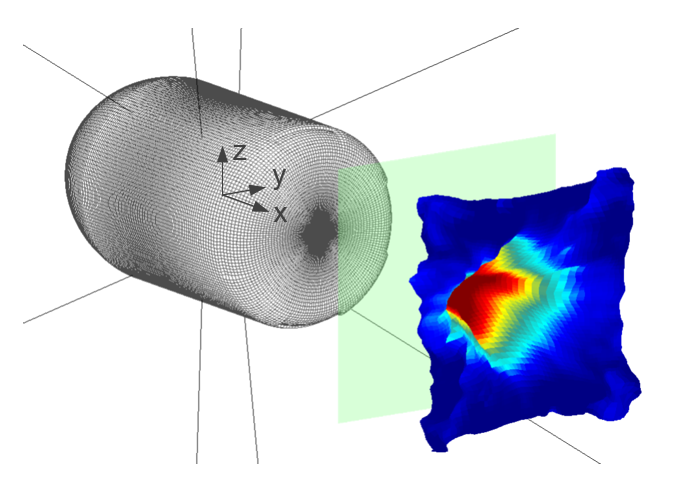
This investigation focuses on fluidic actuation of the wake behind a wind tunnel model of a stationary axisymmetric bluff body. The model is suspended in the wind tunnel by eight thin wires for minimal support interference within the wake. The aerodynamic steering forces and moments are altered by induced segmented attachment of the separated flow over an azimuthal Coanda surface. Such segmented alteration of the base flow induces asymmetric aerodynamic forces and moments, which can be used for maneuvering during flight. Transitory modulation of the actuation waveform of multiple actuators around the tail leads to the generation of significant dynamic side forces of controlled magnitude and direction with the potential utility for flight stabilization and fast maneuvering.
REFERENCES
Abramson, P., Vukasinovic, B., and Glezer, A., Fluidic Control of Aerodynamic Forces on a Bluff Body of Revolution, AIAA J. 50, pp.832-843, 2012.
Abramson, P., Vukasinovic, B., and Glezer, A., Direct Measurements of Controlled Aerodynamic Forces on a Wire-suspended Axisymmetric Body, Exp. Fluids 50, pp.1711-1725, 2011.
Abramson, P., Vukasinovic, B., and Glezer, A., Fluidic Control of Steering Aerodynamic Forces on Axisymmetric Bodies using a Mid-Body Cavity, AIAA Paper 2009-4276.
Abramson, P., Culp, J., Vukasinovic, B., and Glezer, A., Fluidic Control of Asymmetric Forces on a Body of Revolution, AIAA Paper 2009-1078.
Abramson, P., Rinehart, C., Vukasinovic, B., and Glezer, A., Fluidic Control of Aerodynamic Forces on a Body of Revolution, AIAA Paper 2007-4505.
Surface-Mounted Hemisphere
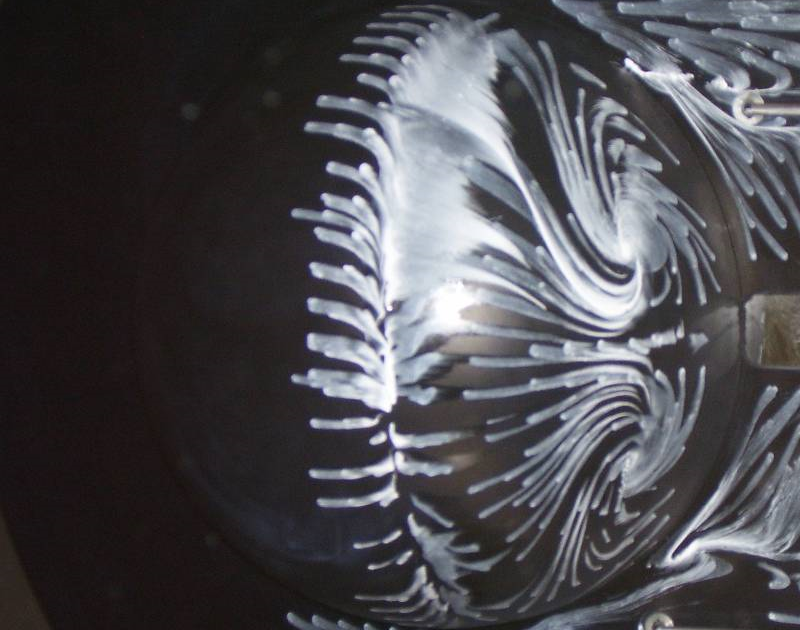
The flow over a hemisphere presents challenges to separation control beyond those associated with the separation behind two-dimensional aerodynamic surfaces. Locally, the development of a shear layer at the origin of a separated region is subject to the same instability considerations as that in a two-dimensional flow. The three-dimensional geometry of the surface, which curves not only in the streamwise but also in the lateral direction, subjects the developing spanwise vorticity lines to distortion that makes the overall separation region fairly complex. The present work draws on previous experience with the application of high-frequency control to explore the response of the separated region behind a hemisphere to various control strategies, including both pure high-frequency and concomitant low- and high-frequency control.
REFERENCES
Vukasinovic, B., Brzozowski, D., and Glezer, A., Fluidic Control of Separation Over a Hemispherical Turret, AIAA J. 47, pp.2212-2222, 2009.
Vukasinovic, B., Glezer, A., Gordeyev, S., Jumper, E., and Kibens, V., Active Control and Optical Diagnostics of the Flow over a Hemispherical Turret, AIAA Paper 2008-598.
Vukasinovic, B., Brzozowski, D., Glezer, A., Bower, W. W., and Kibens, V., Separation Control over a Surface-Mounted Hemispherical Shell, AIAA Paper 2005-4878.
Planar Shear Layer
 The effects of high-frequency fluidic actuation on the evolution of small- and large-scale motions in a turbulent shear layer downstream of a backward-facing step are investigated experimentally. The flow behind the step is characterized in the spatial and spectral domain by high-resolution diagnostic tools. The actuation is applied either as a pure harmonic or amplitude-modulated high-frequency signal, which enhances either direct small-scale motions or both large- and small-scale motions, respectively.
The effects of high-frequency fluidic actuation on the evolution of small- and large-scale motions in a turbulent shear layer downstream of a backward-facing step are investigated experimentally. The flow behind the step is characterized in the spatial and spectral domain by high-resolution diagnostic tools. The actuation is applied either as a pure harmonic or amplitude-modulated high-frequency signal, which enhances either direct small-scale motions or both large- and small-scale motions, respectively.
REFERENCES
Vukasinovic, B., Rusak, Z., and Glezer, A., Dissipative Small-scale Actuation of a Turbulent Shear Layer, J. Fluid Mech. 656, pp. 51-81, 2010.
Vukasinovic, B., Glezer, A., and Rusak, Z., Experimental and Numerical Investigation of Controlled, Small-Scale Motions in a Turbulent Shear Layer, Proc. 3rdInternational Symposium on Integrating CFD and Experiments, USAFA, June 20-21, 2007.
Vukasinovic, B. and Glezer, A., Transitory Fluidic Control of Turbulent Shear Flows, AIAA Paper 2006-3227.
Vukasinovic, B., Lucas, D. G., and Glezer, A., Controlled Manipulation of Small- and Large-Scales in a Turbulent Shear Layer, Part I: Experimental Studies, AIAA Paper 2005-4753.
Vukasinovic, B., Lucas, D. G., and Glezer, A., Direct Manipulation of Small-Scale Motions in a Plane Shear Layer, AIAA Paper 2004-2617.